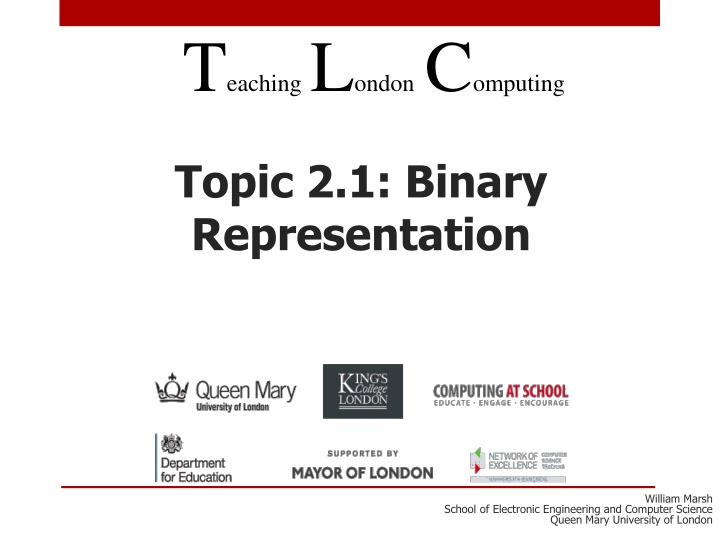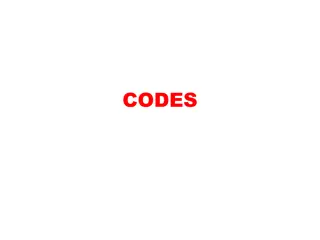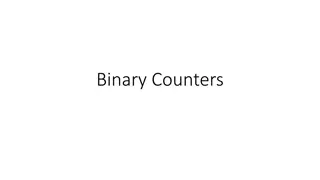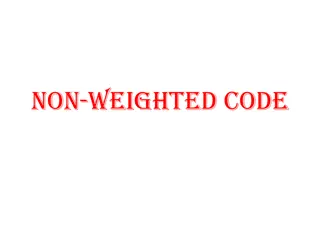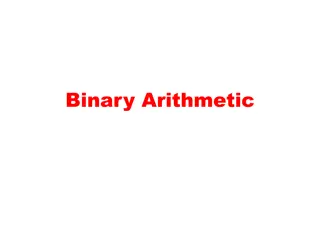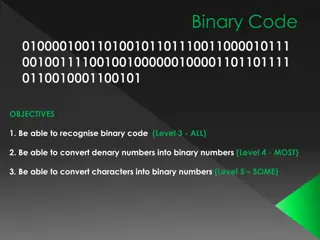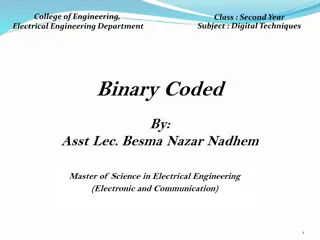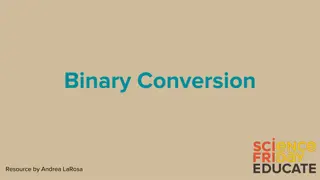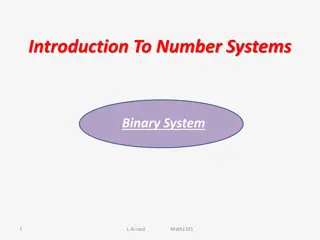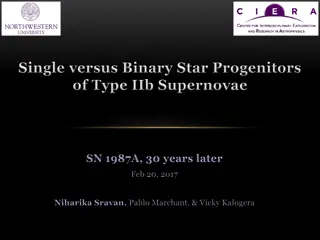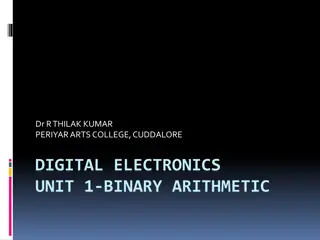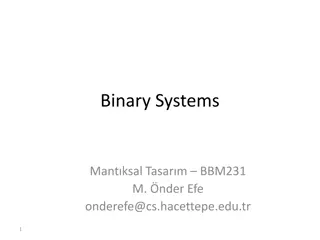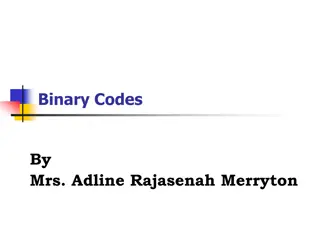Binary Representation Basics
Delve into the fundamentals of binary number representation as explained in the instructional material from William Marsh School of Electronic Engineering and Computer Science at Queen Mary University of London. Learn how to count and perform arithmetic in binary, understand the significance of binary in computing, and explore the transition from analog to digital signals. Discover the simplicity of binary counting and its application in modern computing systems.
Download Presentation

Please find below an Image/Link to download the presentation.
The content on the website is provided AS IS for your information and personal use only. It may not be sold, licensed, or shared on other websites without obtaining consent from the author.If you encounter any issues during the download, it is possible that the publisher has removed the file from their server.
You are allowed to download the files provided on this website for personal or commercial use, subject to the condition that they are used lawfully. All files are the property of their respective owners.
The content on the website is provided AS IS for your information and personal use only. It may not be sold, licensed, or shared on other websites without obtaining consent from the author.
E N D
Presentation Transcript
TeachingLondon Computing Topic 2.1: Binary Representation William Marsh School of Electronic Engineering and Computer Science Queen Mary University of London
Aims Introduce binary number representations Count in binary Do binary arithmetic same rules as normal (decimal), fewer digits Understand that binary also represents Characters
Teaching Issue Some people find this material easy others less so Every one can count and do arithmetic! How to make it as simple as possible? At first, avoid mathematics of exponents (20, 21, 22 etc)
Counting in Tens Why do we count with 10 digits (0-9)? Romans used I, II, III, IV, VI, VII Babylonians counted in 60 Our numbers are Arabic importance of zero Some early computers used decimal Babbage s mechanical computer ENIAC in USA
Switches make Computers Analog versus Digital Analog signal: any value Digital signal: only two values closed open analogue high digital low
Binary Base 2 Decimal Ten digits: 0 to 9 Two digits: 0 and 1 Binary digit bit Count on two fingers
Number After Decimal 0 1 1 2 9 10 Familiar Rules? 18 19 19 20 Rule for the next number Starting from the right hand side, look at each digit d in turn: 99 100 100 101 1. If d not last next and stop 2. If d is last 0, go on to next digit. 3. If there are no more digits, put a 1 999 1000
Number After Binary Two digits Same rules 0 1 1 10 100 101 111 1000 1000 1001 111111 1000000
Quiz Write down the number after each of the following numbers 0 ?? 1 ?? 100 ?? 101 ?? 110 ?? 1000 ?? 1100 ?? 1111 ?? 01101011 ?? 11000111 ?? 00011010 ?? 10100101 ?? 10111111 ?? 11011111 ?? 01111111 ?? 11111111 ??
Quiz Write a list of 4-digit binary numbers in order 0 1 2 3 4 5 6 7 0000 8 9 10 11 12 13 14 15
Binary 0 15 Write a list of 4-digit binary numbers in order 0 1 2 3 4 5 6 7 0000 0001 0010 0011 0100 0101 0110 0111 8 9 10 11 12 13 14 15 1000 1001 1010 1011 1100 1101 1110 1111
Binary 0 15: Patterns Write a list of 4-digit binary numbers in order 0 1 2 3 4 5 6 7 0000 0001 0010 0011 0100 0101 0110 0111 8 9 10 11 12 13 14 15 1000 1001 1010 1011 1100 1101 1110 1111
Binary 0 15: Patterns Write a list of 4-digit binary numbers in order 0 1 2 3 4 5 6 7 0000 0001 0010 0011 0100 0101 0110 0111 8 9 10 11 12 13 14 15 1000 1001 1010 1011 1100 1101 1110 1111
OCTALAND HEXADECIMAL NUMBERS
Octal and Hexadecimal Octal base 8 Hexadecimal base 16 Direct conversion to/from binary
Octal Base 8 octal binary Digits 0 7 Each octal digit is 3 binary digits 0 1 2 3 4 5 6 7 000 001 010 011 100 101 110 111 1011102 5 6 568
Hex Base 16 Digits 0 9, A F hex binary hex binary 0 1 2 3 4 5 6 7 0000 0001 0010 0011 0100 0101 0110 0111 8 9 A B C D E F 1000 1001 1010 1011 1100 1101 1110 1111 Each hex digit stands for 4 binary digits
Hex Example ACH hex binary hex binary 0 1 2 3 4 5 6 7 0000 0001 0010 0011 0100 0101 0110 0111 8 9 A B C D E F 1000 1001 1010 1011 1100 1101 1110 1111 10101100
ASCII American Standard Code for Information Interchange First standardised in 1967 7-bit character code 0 127 Parity bit Characters are Printable 95 Control 33 !"#$%&'()*+,-./0123456789:;<=>? @ABCDEFGHIJKLMNOPQRSTUVWXYZ[\]^_ `abcdefghijklmnopqrstuvwxyz{|}~
ASCII in Hex 0 1 2 3 4 5 6 7 8 9 A B C D E F 0 NUL SOH STX ETX EOT ENQ ACK BEL BS HT LF VT FF CR SO SI 1 DLE DC1 DC2 DC3 DC4 NAK SYN ETB CAN EM SUB ESC FS GS RS US 2 SP ! " # $ % & ' ( ) * + , - . / 3 0 1 2 3 4 5 6 7 8 9 : ; < = > ? 4 @ A B C D E F G H I J K L M N O 5 P Q R S T U V W X Y Z [ \ ] ^ _ 6 ` a b c d e f g h i j k l m n o 7 p q r s t u v w x y z { | } ~ DEL A is 41H = 65 2 is 32H = 50
ASCII Features Digits The digits 0-9 are represented with their values in binary prefixed with 0011 (I.e. 3H) 0 is 30H 9 is 39H
ASCII Features Characters Letters are in a contiguous sequences No gaps Lowercase and uppercase letters 3210 apart Single bit difference A Z : 41H 5AH a z : 61H 7AH
ASCII Limitations Only 95 printable characters accents non-Latin languages Chinese-based scripts Unicode 16 bits Overlaps with ASCII where possible
Adding Binary Digits Very simple rules 0 + 0 = 0 0 + 1 = 1 1 + 0 = 1 1 + 1 = 0 carry 1
Adding Binary Numbers Complete the following 0 1 1 0 0 1 0 1 +
Adding Binary Numbers Complete the following 0 1 1 0 0 1 1 1 1 +
Adding Binary Numbers Complete the following 0 1 1 0 0 1 1 1 1 0 1 + Carry
0 1 2 3 4 5 6 7 8 9 10 11 12 13 14 15 0000 0001 0010 0011 0100 0101 0110 0111 1000 1001 1010 1011 1100 1101 1110 1111 Adding Binary Numbers Complete the following 0 1 1 0 0 1 1 1 1 1 1 1 0 1 +
Quiz Complete 0 1 1 1 0 1 0 0 0 1 0 1 +
Summary Start by counting get used to binary Conversion tables Addition apply standard rules Octal and hexadecimal Easy really At first, avoid mathematics of exponents (20, 21, 22 etc)
